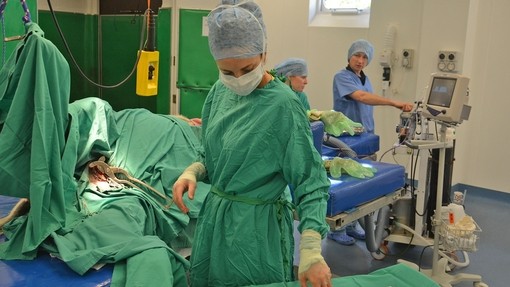Local anaesthetic
For donkeys, use the standard local anaesthesia and regional nerve-blocking techniques used in other equids. You may need to scale down doses of local anaesthetic to reflect the smaller size of the donkey and ensure you do not administer a toxic dose.
Sedation
Perform sedation using either the oral, intramuscular or intravenous routes. The chosen route depends largely on a risk assessment for the donkey and handler.
- The dose of sedative will depend on several factors, including: the anticipated duration, potential pain level of the procedure and the temperament, age, condition and health status of the donkey.
- Administer all commercially available alpha-2 agonists using standard equine doses.
- Romifidine, detomidine and xylazine are all commonly used at The Donkey Sanctuary. Selection is according to personal preference and the procedure undertaken.
- Typically, the alpha-2 agonists are combined with an opioid, most commonly butorphanol. Alternatively, use buprenorphine or morphine if you anticipate a more painful procedure.
Sedation top-ups may need to be more frequent in the donkey.
General anaesthesia
Use an indwelling catheter wherever possible as top-ups need to be frequent.
A typical anaesthetic protocol used at The Donkey Sanctuary would be:
- Pre-med: ACP 0.03mg/kg bwt by IV or IM injection, 30 minutes prior to sedation with alpha-2 agonist.
- Sedation prior to induction: Xylazine 1.1mg/kg bwt IV or detomidine 0.02mg/kg bwt IV. Administer butorphanol with the alpha-2 agonist at 0.02mg/kg bwt; or buprenorphine at 5-10μg/kg (this requires a five-minute wait after administering the alpha-2 agonist to avoid excitation).
- Induction: Ketamine 2.2-2.8mg/kg bwt IV, diazepam 0.1mg/kg bwt IV.
- Only proceed to induction if the donkey is sufficiently sedated. The head should be below the withers and the body relaxed, otherwise increase the dose of sedative.
- Maintenance: Use isoflurane/oxygen, triple drip, or ketamine/alpha-2 agonist top-ups, depending on the situation.
Monitoring the depth of anaesthesia in donkeys can be challenging. Eye position, pulse, respiratory rate, blood pressure and muscle tension can be less predictable than in horses and ponies.
An alternative anaesthetic combination for short in-field procedures involves the use of a triple drip. Procedures should be under 45 minutes or supplemental oxygen is needed.
Guaiphenesin clearance is slower in donkeys than in horses and ponies, therefore avoid doses greater than 150mg/kg as toxic effects occur at these high doses.
See Factsheet: Triple Drip Combination for Induction and Maintenance of Anaesthesia in Donkeys for the recipe used at The Donkey Sanctuary.
- When using ketamine top-ups, give boluses every 10-15 minutes, rather than every 15-20 minutes, as in horses.
- Typically, use one third of the induction dose of ketamine and alpha-2 agonist for top-ups.
- Using more than two ketamine top-ups may cause the donkey to be ataxic on recovery, requiring further sedation to avoid injury.
Endotracheal intubation of donkeys can prove difficult due to their shorter, more pointed epiglottis and caudally tilted laryngeal opening. The trachea is also narrower relative to other equine species.
Donkeys are usually far calmer in recovery than horses and rarely require sedation in the recovery period. They will usually achieve sternal recumbency early on in recovery and only attempt standing when ready. Donkeys rarely require assistance, although occasionally you may need to give some encouragement.
Analgesia
Do not forget analgesia provision in donkeys. They may show fewer signs of pain than a horse due to their stoic nature.
The Donkey Sanctuary commonly uses:
- Phenylbutazone given at a loading dose 4.4mg/kg BID followed by 2.2mg/kg BID.
- Flunixin at 1.1mg/kg BID.
- Carprofen at 0.7-1.3 mg/kg SID - for more chronic pain (such as osteoarthritis).
- Paracetamol at 20mg/kg bwt BID - for chronic pain or as part of a multimodal post-operative approach.
The Donkey Sanctuary has used opioids including morphine, buprenorphine and fentanyl patches. There is poor evidence for many of the newer analgesic drugs in donkeys due to a lack of research, so doses are extrapolated from equine data and by monitoring the response to pain.
The Donkey Sanctuary does not currently advise the use of meloxicam in donkeys as it appears to be metabolised too quickly to have any lasting efficacy.




